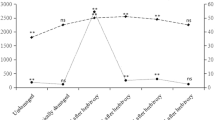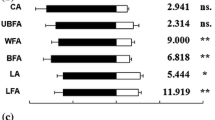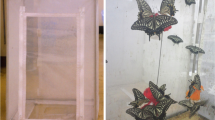Abstract
Electroantennograms were recorded from an herbivore,Pseudoplusia includens (Walker) (Lepidoptera: Noctuidae), and a parasitoid,Microplitis demolitor (Wilkinson) (Hymenoptera: Braconidae), exposed to 5-through 12-carbon aliphatic compounds of several chemical classes. The response of the herbivore was higher for the 6- and/or 7-carbon hydrocarbons, alcohols, aldehydes, esters, and ketones. The response of the parasitoid was higher for the 7- and 8-carbon hydrocarbons, aldehydes, and ketones. Responses of the herbivore and the parasitoid to alcohols were similar. Both the herbivore and the parasitoid were most sensitive to aldehydes and ketones, and least sensitive to alcohols and hydrocarbons. Responses of the parasitoid to hydrocarbons, aldehydes, and ketones were numerically higher than those of the herbivore. The adaptive significance of differential olfactory sensitivity between the herbivore and the natural enemy is discussed in relation to tri-trophic interactions among plants, herbivores, and natural enemies.
Similar content being viewed by others
References
Baehreche, E.H., Williams, H.J., andVinson, S.B. 1989. Electroantennogram responses ofCampoletis sonorensis (Hymenoptera: Ichneumonidae) to chemicals in cotton (Gossypium hirsutum L).J. Chem. Ecol. 15:37–45.
Bedard, W.D., Tilden, P.E., Wood, D.L., Silverstein, R.M., Brownlee, R.G., andRodin, J.O. 1969. Western pine beetles: Field response to its sex pheromone and a synergistic host terpene myrcene.Science 164:1284–1285.
Bedard, W.D., Wood, D.L., Tilden, P.E., Lindahl, K.Q., Jr., Silverstein, R.M., andRodin, J.O. 1980. Field responses of the western pine beetle and one of its predators to host- and beetle-produced compounds.J. Chem. Ecol. 6:625–641.
Bjostad, L.B. 1988. Insect electroantennogram responses to semiochemicals recorded with an inexpensive personal computer.Physiol. Entomol. 13:139–145.
Blust, M.H., andHopkins, L.T. 1987. Olfactory responses of a specialist and a generalist grass-hopper to volatiles ofArtemisia ludoviciana Nutt. (Asteraceae).J. Chem. Ecol. 13:1893–1901.
Buttery, R.G., andLing, L.C. 1985. Volatile components of com roots: possible insect attractants.J. Agric. Food Chem. 33:772–774.
Buttery, R.G., Kamm, J.A., andLing, L.C. 1984. Volatile components of red clover leaves, flowers, and seed pods: Possible insect attractants.J. Agric. Food Chem. 32:254–256.
Connick, W.J., Bradow, J.M., andLegendre, M.G. 1989. Identification and bioactivity of volatile allelochemicals from amaranth residues.J. Agric. Food Chem. 37:792–796.
Dicke, M., andSabelis, M.W. 1989. Does it pay plants to advertise for bodyguards? Towards a cost-benefit analysis of induced synomone production, pp. 341–358in H. Lambers, M.L. Cambridge, H. Konings, and T.L. Pons (eds.). Causes and Consequences Variation in Growth Rate and Productivity of Higher Plants. SPB Academic Publishing, The Hague.
Dicke, M., Van Beek, T.A., Posthumus, M.A., Ben Dom, N., Van Bokhoven, H., andDe Groot, A.E. 1990. Isolation and identification of volatile kairomone that affects acarine predator-prey interactions: Involvement of host plant in its production.J. Chem. Ecol. 16:381–396.
Dickens, J.C. 1984. Olfaction in the boll weevil,Anthonomus grandis Boh. (Coleoptera: Circulionidae): Electroantennogram studies.J. Chem. Ecol. 10:1759–1785.
Dickens, J.C. 1989. Green leaf volatiles enhance aggregation pheromone of boll weevil,Anthonomus grandis.Entomol. Exp. Appl. 52:191–204.
Dickens, J.C., andBoldt, P.E. 1985. Electroantennogram responses ofTrirhabda bracharides (Weber) (Coleoptera: Chrysomelidae) to plant volatiles.J. Chem. Ecol. 11:767–779.
Eller, F.J., Tumlinson, J.H., andLewis, W.J. 1988. Beneficial arthropod behavior mediated by airborne semiochemicals: source of volatiles mediating the host-location flight behavior ofMicroplitis croceipes (cresson) (Hymenoptera: Braconidae), a parasitoid ofHeliothis zea (Boddie) (Lepidoptera: Noctuidae).Environ. Entomol. 17:745–753.
Elzen, G.W., Williams, H.J., andVinson, S.B. 1983. Response by the parasitoidCampoletis sonorensis (Hymenoptera: Ichneumonidae) to chemicals (synomones) in plants: Implications for host habitat location.Environ. Entomol. 12:1872–1876.
Elzen, G.W., Williams, H.J., andVinson, S.B. 1986. Wind tunnel flight responses by hyme-nopterous parasitoidCompoletis sonorensis to cotton cultivars and lines.Entomol. Exp. Appl. 42:285–289.
Gilbert, B.L., andNorris, D.M. 1968. A chemical basis for bark beetle (Scolytus) distinction between host and non-host trees.J. Insect Physiol. 14:1063–1068.
Gilbert, B.L., Baker, J.E., andNorris, D.M. 1967. Juglone (5-hydroxy-1,4-naphthoquinone) fromCarya ovata, a deterrent to feeding byScolytus multistriastus.J. Insect Physiol. 13:1453–1459.
Guerin, P.M., andStaedler, E. 1982. Host odour perception in three phytophagous Diptera—A comparative study, pp. 95–105.in J.H. Visser and A.K. Minks (eds.). Proceedings, 5th International Symposium on Insect-plant Relationships. Wageningen, Pudoc, Wageningen.
Guerin, P.M., andVisser, J.H. 1980. Electroantennogram responses of the carrot fly,Psila rosae to volatile plant components.Physiol. Entomol. 5:111–119.
Hamilton-Kemp, T.R., Anderson, R.A., Rodriguez, J.G., Loughrin, J.H., andPatterson, C.G. 1988. Strawberry foliage headspace vapor components at periods of susceptibility and resistance toTetranychus urticae Koch.J. Chem. Ecol. 14:789–796.
Hamilton-Kemp, T.R., Rodriquez, J.G., Archbold, D.D., Andersen, R.A., Loughrin, J.H., Patterson, C.G., andLowry, S.R. 1989. Strawberry resistance toTetranychus urticae Koch: Effects of flower, fruit and foliage removal comparisons of air-vs. nitrogen-entrained volatile compounds.J. Chem. Ecol. 15:1465–1473.
Hansson, B.S., Van Der Pers, J.N.C., andLofqvist, J. 1989. Comparison of male and female olfactory cell response to pheromone compounds and plant volatiles in the turnip moth,Agrotis segetum.Physiol. Entomol. 14:147–155.
Herard, F., Keller, M.A., andLewis, W.J. 1988. RearingMicroplitis demolitor (Wilkinson) in the laboratory for use in studies of semiochemical mediated searching behavior.J. Entomol. Sci. 23:105–111.
Hendry, L.B., Greany, P.D., andGill, R.J. 1973. Kairomone mediated host-finding behaviour in the parasitic waspOrgilus lepidus.Entomol. Exp. Appl. 16: 471–477.
Hernandez, H.P., Hsieh, T.C-Y., Smith, C.M., andFischer, N.H. 1989. Foliage volatiles of two rice cultivars.Phytochemistry 28:2959–2962.
Honda, H., Maruyama, Y., andMatsumoto, Y. 1986. Comparison in EAG response to n-alkyl compounds between fruit- and Pinaceae-feeding type of yellow peach moth,Conogethes punctiferalis (Guenée) (Lepidoptera: Pyralidae).Appl. Entomol. Zool. 21:399–404.
Jermy, T. 1966. Feeding inhibitors and food preference in chewing phytophagous insects.Entomol. Exp. Appl. 9:1–12.
Jermy, T. 1976. The Host-Plant in Relation to Insect Behavior and Reproduction. Plenum Press. New York.
Khan, Z.R., Cieptela, A., andNorris, D.M. 1987. Behavioral and physiological responses of cabbage looper,Trichoplusia ni (Hubner), to steam distillates from resistant versus susceptible soybean plants.J. Chem. Ecol. 13:1903–1915.
Kozlowski, M.W., andVisser, J.H. 1981. Host plant related properties of the antennal olfactory system in the oak flea weevil,Rynchaenus guercus. Electroantennogram study.Entomol. Exp. Appl. 30:169–175.
Landolt, P.J. 1989. Attraction of the cabbage looper to host plants and host plant odor in the laboratory.Entomol. Exp. Appl. 53:117–124.
Landolt, P.J., andHeath, R.R. 1990. Sexual role reversal in mate-finding strategies of the cabbage looper moth.Science 249:1026–1028.
Lanne, B.S., Schlyter, G., Byers, J.A., Lofqvist, J., Leufven, A., Bergstrom, G., Van Der Pers, J.N.C., Unelius, R., Baeckstrom, P., andNorin, T. 1987. Differences in attraction to semiochemicals present in sympatric pine shoot beetles,Tomicus minor andT. piniperda.J. Chem. Ecol. 13:1045–1067.
Lecomte, C., andPouzat, J. 1985. Responses electroantennographiques de deux parasitoides Ichneumonides,Diadromus pulchellus etD. collaris, aux odeurs de vegetaux, du phytophagehoteAcrolepiopsis assectella et du partenaire sexuel.Entomol. Exp. Appl. 39:295–306.
Lewis, W.J., andTumlinson, J.H. 1988. Host detection by chemically mediated associative learning in a parasitic wasp.Nature 331:257–259.
Light, D.M., andJang, E.B. 1987. Electroantennogram responses of the oriental fruit fly,Dacus dorsalis, to spectrum of alcohol and aldehyde plant volatiles.Entomol. Exp. Appl. 45:55–64.
Liu, S.-H., Norris, D.M., andMarti, E. 1988. Behavioral responses of female adultTrichoplusia ni to volatiles from soybeans versus a preferred host, lima bean.Entomol. Exp. Appl. 49:99–109.
Liu, S.-H., Norris, D.M., andLyne, P. 1989. Volatiles from the foliage of soybean,Glycine max, and lima bean,Phaseolus lunatus: Their behavioral effects on the insectsTrichoplusia ni andEpilachna varivestis.J. Agric. Food Chem. 37:496–501.
Loke, W.H., Ashley, T.R., andSailer, R.I. 1988. Influence of fall armyworm,Spodoptera frugiperda (Lepidoptera: Noctuidae), larvae and corn plant damage on host rinding inApanteles marginiventris (Hymenoptera: Braconidae).Environ. Entomol. 12:911–915.
Lwande, W., McDowell, P.G., Amiani, H., andAmoke, P. 1989. Analysis of airborne volatiles of cowpea.Phytochemistry 28:421–423.
Martin, W.R., Nordlund, D.A., andNettles, W.C. 1990. Response of parasitoidEucelatoria bryani to selected plant material in an olfactometer.J. Chem. Ecol. 16:499–508.
McAuslane, H.J., Vinson, S.B., andWilliams, H.J. 1990. Influence of host plant on mate location by parasitoidCampoletis sonorensis (Hymenoptera: Ichneumonidae).Environ. Entomol. 19:26–31.
Metcalf, R.L. 1986. Plant volatiles as insect attractants.Crit. Rev. Plant Sci. 5:251–301.
Nadel, H., andVan Alphen, J.J.M. 1987. The role of host-and host-plant odours in the attraction of a parasitoid,Edidinocarsis lopezi, to the habitat of its host, the cassava mealybug,Phenacoccus manihoti.Entomol. Exp. Appl. 45:181–186.
Navasero, R.C., andElzen, G.W. 1989. Response ofMicroplitis croceipes to host and nonhost plants ofHeliothis virescens in a wind tunnel.Entomol. Exp. Appl. 53:57–63.
Norris, D.M. 1986. Anti-feeding compounds, pp. 97–146,in G. Haug and H. Hoffman (eds.). Chemistry of Plant Protection, Vol. I. Springer-Verlag, Berlin.
Nordlund, D.A., Lewis, W.J., andAltieri, M.A. 1988. Influences of plant-produced allelo-chemicals on the host/prey selection behavior of entomophagous insects, pp. 65–90,in P. Barbosa and D. Letourneau (eds.). Novel Aspects of Insect-Plant Interactions. John Wiley, New York.
Odell, T.M., andGodwin, P.A. 1984. Host selection byBlepharipa pratensis (Meigen), a tachinid parasite of the gypsy moth,Lymantria dispar L.J. Chem. Ecol. 10:311–320.
Payne, T.L. 1975. Bark beetle olfaction. III. Antennal olfactory responsiveness ofDendroctonus frontalis Zimmerman andD. brevicomis Le Conte (Coleoptera: Scolytidae) to aggregation pheromones and host tree terpene hydrocarbons.J. Chem. Ecol. 1:233–242.
Price, P.W. 1986. Ecological aspects of host plant resistance and biological control: Interactions among three trophics levels, pp. 11–30in D.J. Boethel and R.D. Eikenbarry (eds.). Interactions of Plant Resistance and Parasitoid Predators of Insects. Ellis Horwood Limited, Chicester, England.
Price, P.W., Bouton, C.E., Gross, P., McPheron, B.A., Thompson, J.N., andWeis, A.E. 1980. Interactions among three trophic levels: Influence of plants on interactions between insect herbivores and natural enemies.Annu. Rev. Ecol. Syst. 11:41–65.
Ramachandran, R., Khan, Z.R., Caballero, P., andJuliano, B.O. 1990. Olfactory sensitivity of two sympatric species of rice leaf-folders (Lepidoptera: Pyralidae) to plant volatiles.J. Chem. Ecol. 16:2647–2666.
Reid, C.D., andLampan, R.L. 1989. Olfactory responses ofOrius insidiosus (Hemiptera: Anthocoridae) to volatiles of corn silk.J. Chem. Ecol. 15:1109–1115.
Roelofs, W.L. 1984. Electroantennogram assays: Rapid and convenient screening procedures for pheromones, pp. 131–160,in H.E. Hummel and T.A. Miller (eds.). Techniques in Pheromone Research. Springer-Verlag, Berlin.
Saijo, R., andTakeo, T. 1975. Increase of cis-3-hexen-1 -ol content in tea leaves following mechanical injury.Phytochemistry 14:181–182.
Sato, Y. 1979. Experimental studies on parasitization byApanteles glomeratus. IV. Factors leading a female to the host.Physiol. Entomol. 4:63–70.
Schneider, D. 1957. Elektrophysiologische Untersuchungeu von Chemo-und Mechanorezeptoren der Antenne des SeidenspinnersBombyx mori L.Z. Vergl. Physiol. 40:8–41.
Schoonhoven, L.M. 1968. Chemosensory bases of host plant selection.Annu. Rev. Entomol. 13:115–116.
Sheehan, W., andShelton, A.M. 1989. The role of experience in plant foraging by the aphid parasitoidDiaeretiella rapae (Hymenoptera: Aphidiidae).J. Insect Behav. 2:743–759.
Sheppard, M., Lawn, R.T., andSchneider, M. 1983a. Insects on grain legumes in north Australia: A survey of potential pests and their enemies. University of Queensland Press, Brisbane, Australia. 90 pp.
Sheppard, M., Powel, I.E., andJones, W.A., Jr. 1983b. Biology ofMicroplitis demolitor (Hymenoptera: Braconidae) an imported parasitoid of Heliothis (Lepidoptera: Noctuidae) spp. and the soybean looper,Pseudoplusia includens (Lepidoptera: Noctuidae).Environ. Entomol. 12:641–645.
Shorey, H.H., andHale, R.L. 1965. Mass-rearing of the larvae of nine noctuid species on a simple artificial medium.J. Econ. Entomol. 58:522–524.
Staedler, E. 1976. Sensory aspects of insect plant interactions. Proceedings, XV International Congress on Entomology, Washington, pp. 228–248.
Tollsten, L., andBergström, G. 1988. Headspace volatiles of whole plants and macerated plant parts ofBrassica sinapis.Photochemistry 27:4013–4018.
Turlings, T.C.J., Tumlinson, J.H., andLewis, W.J. 1990. Exploitation of herbivore-induced plant odors by host-seeking parasitic wasp.Science 250:1251–1253.
Van Der Pers, J.N.C. 1981. Comparison of electroantennogram response spectra to plant volatiles in seven species ofFponomenta and in the torricidAdoxophyes Orana.Entomol. Exp. Appl. 30:181–192.
Van Straten, S., andMaarse, H. 1983. Volatile compounds in food, 5th ed. Central Institute for Nutrition and food Research TNO, Zeist, The Netherlands.
Vinson, S.B. 1984. Parasite-host relationships, pp. 205–233.in W.J. Bell and R.T. Cardé (eds.). Chemical Ecology of Insects. Chapman and Hall, London.
Visser, J.H. 1979. Electroantennogram responses of the Colorado beetle,Leptinotarsa decemlineata to plant volatiles.Entomol. Exp. Appl. 25:86–97.
Visser, J.H. 1983. Differential sensory perceptions of plant compounds by insects, pp. 215–230,in P.A. Hedin (ed.). Plant Resistance to Insects. ACS Symposium Series 208. American Chemical Society, Washington. D.C.
Visser, J.H. 1986. Host odor perception in phytophagous insects.Annu. Rev. Entomol. 31:121–144.
Visser, J.H., andAve, D.A. 1978. General green leaf volatiles in the olfactory orientation of the Colorado beetle,Leptinotarsa decemlineata.Entomol. Exp. Appl. 24:538–549.
Visser, J.H., andThiery, D. 1985. Behavioral responses of Colorado potato beetle to stimulation by wind and plant odors.Bull. Agric. Exp. Stn. Univ. Mass. 704:117–125.
Visser, J.H., Van Straten, S., andMaarse, H. 1979. Isolation and identification of volatiles in the foliage of potato,Solanum tuberosum, a host plant of the Colorado beetle,Leptinotarsa decemlineata.J. Chem. Ecol. 5:13–25.
Wallbank, B., andWheately, G.A. 1976. Volatile contituents from cauliflower and other crucifers.Phytochemistry 15:763–766.
Whitehead, A.T. 1986. Electroantennogram responses by mountain pine beetles,Dendtroctonus ponderosae Hopkins, exposed to selected semiochemicals.J. Chem. Ecol. 12:1603–1621.
Whitman, D.W. 1988a. Plant natural products as parasitoid cuing agents, pp. 386–396,in H.G. Cuttler (ed.). Biologically Active Natural Products Potential use in Agriculture. ACS Symposium Series 380. American Chemical Society, Washington, D.C.
Whitman, D.W. 1988b. Allelochemical interactions among plants, herbivores, and their predators, pp. 11–64,in P. Barbosa and G.K. Letourneau (eds.). Novel Aspects of Insect-Plant Interactions. John Wiley, New York.
Whitman, D.W., andEller, F.J. 1990. Parasitic wasps orient to green leaf volatiles.Chemo-ecology 1:69–76.
Zar, J.H. 1984. Biostatistical Analysis. Prentice-Hall, Englewood Cliffs, New Jersey. 718 pp.
Author information
Authors and Affiliations
Rights and permissions
About this article
Cite this article
Ramachandran, R., Norris, D.M. Volatiles mediating plant-herbivore-natural enemy interactions: Electroantennogram responses of soybean looper,Pseudoplusia includens, and a parasitoid,Microplitis demolitor, to green leaf volatiles. J Chem Ecol 17, 1665–1690 (1991). https://doi.org/10.1007/BF00984696
Received:
Accepted:
Issue Date:
DOI: https://doi.org/10.1007/BF00984696




